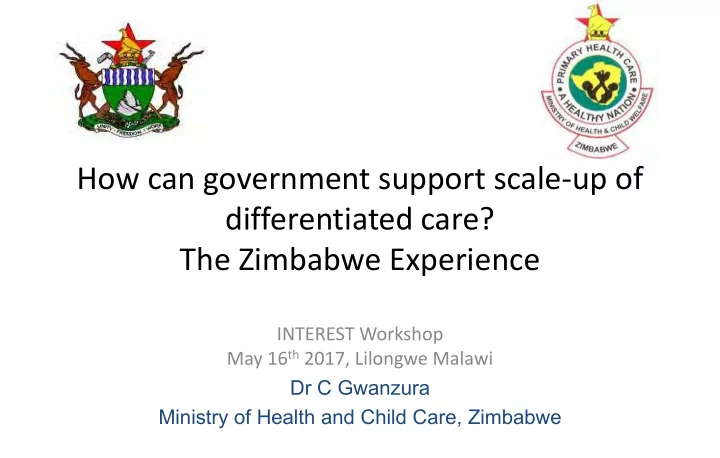

How can government support scale-up of differentiated care? The Zimbabwe Experience INTEREST Workshop May 16 th 2017, Lilongwe Malawi Dr C Gwanzura Ministry of Health and Child Care, Zimbabwe
Presentation Outline • Country Context • Differentiated Service Delivery (DSD) Guidelines in the OSDM • Special considerations in DSD – Children and Adolescents – Pregnant women – Key populations • Progress Update
Country Context • In Zimbabwe, 1.4 million people living with HIV – HIV prevalence among 15 – 64 year age group is 14.6% Data from ZIMPHIA towards 90-90-90 1,425,762 74.2% 89% 86.5% Estimated PLHIV Known HIV Status PLHIV on ART (Sept PLHIV Virally 2016) Suppressed
National response to HIV has been cross cutting and comprehensive -A multi-sectoral and multidisciplinary response - Implementation is guided by the ZNASP III, eMTCT strategy, Guided, Cross- Consolidated ARV Guidelines for Preventing and Treating HIV, VMMC cutting Response Operational Plan etc. A public health approach to scale up of HIV prevention, care & treatment Public health -Population based Approach -Evidence based -Simplified tools and guidelines Implementation is undertaken in the context of a comprehensive Comprehensive combination HIV prevention, treatment, care and comprehensive context for HIV support package that addresses all implementation
Operational Service Delivery Manual (OSDM) and Job Aide
OSDM for the Prevention, Care and Treatment of HIV in Zimbabwe • Guidance on the “how to” to implement the National Guidelines • Defines the minimum package of care per service delivery level, decentralisation scope of practice and capacity building strategies for health workers, • Emphasizes on integration of services • Identifies Differentiated care across the cascade strategies acrpss the cascade • Highlights special considerations for children, adolescents, pregnant and lactating women • Four models for ART delivery highlighted in the OSDM • ”.
Differentiated ART delivery Differentiated Testing Differentiated Initiation
Differentiated Testing and Identification Strategies Moon light testing/ extended Community based hours for special populations - Outreach testing, Index case household testing, -self testing Facility Based - Family Centred Approach, VCT, PITC HIV Testing and counselling Primary care counsellor OI screening Nurses
Special Considerations for HIV testing for Specific Populations • After School, weekends testing Children & • Opt Out in OPD, Schools/Colleges, Door to Door adolescents • Peer to peer mobilisation and testing • SRH education, FP advice and services Pregnant and • Integration of res-testing in facility and EPI outreach activities breastfeeding • HIV self – testing as an option for partner testing women • Moonlight testing • Hots spots, Bars and door to door Key populations • Peer sex workers mobilisation and testing, self Testing • STI Treatment, condom distribution, SGBV education (PrEP)
Linkage to Care for PLHIV • Tested at facility Guided by HCW to assessment for ART • Tested in the community Linked, with their consent, with a community health worker or community based expert client • Tracing of HIV+ clients not linked to care after 1 month after receiving their consent
Differentiated ART Initiation Eligibility criteria Community based initiation by PSI (pilot) Facility based initiation - Stable vs. unstable clients - Early presenters vs. late presenters Initiations Health Care workers for both CD4 & VL sample collection community based and facility Counselling based ART initiation OI screening
Differentiated ART Follow-up Three monthly refills Facility based Six monthly clinical visits - Family ART club - Individual pharmacy refill - Multi-month drug dispensing Community based - Community ART group Medicine refills three monthly Health care worker at Facility Clinical visits once every 6 Peer provider at community months for VL and clinical based monitoring Community based adherence support
Special Considerations for ART follow-up for Specific Populations • Paediatric Disclosure Counselling, longer refills for boarders, adolescent and young adult peer counselling and defaulter tracing Children & • 0-2yrs: One month refills in MCH, 2 – 5yrs: Three month refills in Adolescents MCH through family approach, >5yrs: Group refills with guardians, Outside schools hours / weekends • Integration of PMTCT and MNCH antenatally and postnatally, Group Pregnant and ART refill offer for peer support: Expert clients with PMTCT breastfeeding experience, Breastfeeding women and exposed infants seen on the same day, Choice of refill option for women already on ART, PLUS women ANC/PNC • Specific service times - Clinic hours extension/ weekends, peer Key & mobile counselling and defaulter tracing, integrated package of medical care Populations (e.g. STI screening and treatment, condom distribution etc.), clinically stable have same refill options as general population People with • Linking with local rehabilitative and specialist services disabilities • Sign and braille languages offered where possible
Differentiated ART Delivery for Unstable Clients (HVL) • Content of enhanced • Flagging systems to adherence –session – identify who needs viral load guides in OSDM; check and list on job aide – those with high viral load • Viral load monitoring • > 1000 ACTION • Switching to 2 nd line < 2 weeks, done by qualified personnel
Factors making DSD possible in Zimbabwe Good Existing Strong health Decentralized MOHCC infrastructure HIV services leadership and work force Supportive Support Supportive donor and buy in implementing partners from PLHIV partners Policy for DSD task sharing guidelines, and task Job aide and shifting OSDM 15
We still have challenges requiring innovation in the scale up process Limited access to viral load monitoring, Community models not well accepted in urban and peri -urban areas, Limited funding to scale up DSD effectively to all sites. 16
DSD Scale Up Plan: National Priority Agenda • Sensitization of all provinces on updated OSDM and DSD SOPs, • Setting up DSD Demonstration/learning sites for exchange visits, • Roll out of comprehensive DSD models to all districts gradually utilizing the learning sites as models, • Agreed on core DSD indicators, working committee formulated, etc. 17
Acknowledgements 18
Recommend
More recommend